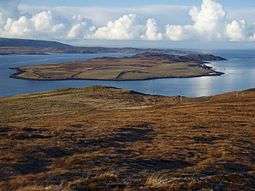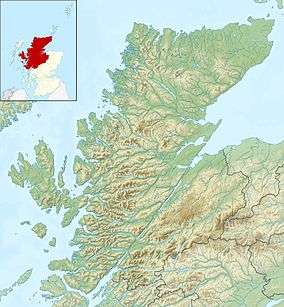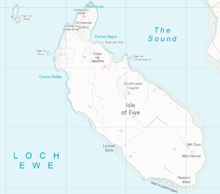Isle of Ewe
The Isle of Ewe (Scottish Gaelic: Eilean Iùbh) is a small Scottish island on the west coast of Ross and Cromarty. The island is inhabited by a single family, the Grants, who have lived at the Main House in the south of the island since the mid-19th century.
| Gaelic name | Eilean Iùbh |
|---|---|
| Pronunciation | [ˈelan ˈjuː] ( |
| Meaning of name | Yew |
 Looking north west over the Isle of Ewe | |
| Location | |
 Isle of Ewe Isle of Ewe shown within Highland Scotland | |
| OS grid reference | NG855885 |
| Coordinates | 57.83°N 5.61°W |
| Physical geography | |
| Island group | Loch Ewe |
| Area | 309 ha (760 acres) |
| Area rank | 87= [1] |
| Highest elevation | Creag Streap 72 m (236 ft) |
| Administration | |
| Sovereign state | United Kingdom |
| Country | Scotland |
| Council area | Highland |
| Demographics | |
| Population | 7[2] |
| Population rank | 72= [1] |
| Population density | 2.2/km2 (5.7/sq mi)[2][3] |
| References | [3][4] |
The island is privately owned by J.I.H. Macdonald-Buchanan and leased to the Grants. The island previously had more families, but these left during the Second World War, when Loch Ewe was used as an important naval anchorage. The isolated position of the island meant that the children had to endure a round trip each day of about 26 miles (42 kilometres) by boat and bus to attend school.[3]
Origin of the name
There are two competing theories about the meaning of the name; it may be derived from the Old Irish eo, "yew tree", or alternatively from the Gaelic eubh, "echo", reflecting a place-name on the adjoining mainland.
Geography and geology

The Isle of Ewe is located in Loch Ewe, west of Aultbea in the Ross and Cromarty district of the Highland Region. The island is made up of two principal types of sandstone (Torridonian with acidic soil in the north, Permian or Triassic with more fertile soil in the south) and the shore line varies from flat pebble beaches to cliffs. It is part of the Wester Ross National Scenic Area, one of 40 in Scotland.[5]
The island was originally wooded, as recorded in 1549 by Donald Monro who wrote in his Description of the Western Isles of Scotland: "Ellan Ew, haffe myle in length, full of woods, guid for thieves to wait upon uther mens gaire. It perteins to M’Enzie."[6] Similarly, George Buchanan wrote in his Rerum Scoticarum Historia (History of Scotland) of 1579 that the island was "almost all covered with woods, and good for nothing but to harbour thieves, who rob passengers." Both Monro and Buchanan (who probably used Munro as a source) mistakenly located the island in Loch Broom, instead of Loch Ewe.[7][8] By the time Black's Picturesque Tourist of Scotland was published in 1889, the Isle of Ewe was "in a state of high cultivation; the fields large and well fenced, having been all reclaimed from moorland. There is an extensive dairy on the island."[9] Today the southern island is predominately low-lying farmland, while its northern part remains uncultivated.[3]
The most elevated part of the Isle of Ewe is its northern peninsula, rising to 72 metres (236 feet) at Creag Streap ("climbing cliff"); a prominent rock, Sgeir a' Bhuich ("rock of the roe-buck") lies just offshore, with a larger rocky island, Sgeir an Araig, situated further out in the loch to the north-west of the Isle of Ewe. A peaty hilly area called Sitheanan Dubha ("the black fairy hillocks") occupies most of the island's northern peninsula. It reaches a height of 68 metres (223 feet) and is dominated by coarse grass, heather and sphagnum moss.[3] In the 1880s, a group of boys reported seeing fairies at that spot.[10] Immediately to the south are two bays – Camas Angus ("Angus' bay") and Camas Beithe ("birch-tree bay") – that afford anchorage to boats. The hummock of Cnoc na Gaoithe ("windy knoll") provides shelter to the two bays. The arable land begins a short distance further south beyond Druium nam Freumh ("ridge of roots"), where a small area of woodland stands. A jetty, built after the Second World War, provides boat access to the mainland.[3]
The island has no regularly scheduled boat service, but access can be arranged at Aultbea.[3]
Cultural references
Because the name of the island sounds like "I love you", it has become popular for couples to take boat trips around the island.[11]
For the same reason, it was also featured as a desert island in the second chapter of Telltale Games' adventure game Tales of Monkey Island: The Siege of Spinner Cay.[12]
The island's name also came up in The Goon Show, during the November 1954 episode "Lurgi Strikes Britain." Neddie Seagoon is informed that the "dreaded lurgi" has appeared on the Isle of Ewe, to which he replies, "I love you too. Shall we dance?"[13]
See also
Footnotes
- Area and population ranks: there are c. 300 islands over 20 ha in extent and 93 permanently inhabited islands were listed in the 2011 census.
- National Records of Scotland (15 August 2013). "Appendix 2: Population and households on Scotland's Inhabited Islands" (PDF). Statistical Bulletin: 2011 Census: First Results on Population and Household Estimates for Scotland Release 1C (Part Two) (PDF) (Report). SG/2013/126. Retrieved 14 August 2020.
- Haswell-Smith (2004) pp. 184–187
- Ordnance Survey: Landranger map sheet 19 Gairloch & Ullapool (Loch Maree) (Map). Ordnance Survey. 2013. ISBN 9780319231074.
- "National Scenic Areas" Archived 2017-03-11 at the Wayback Machine. SNH. Retrieved 30 Mar 2011.
- Monro (1549) "Ellan Ew" no. 177
- Buchanan, George (1831). The History of Scotland, Translated from the Latin. London: Henry Fisher & Son.
- Munro (1961) p. 165
- Black's Picturesque Tourist of Scotland. Edinburgh: Adam & Charles Black. 1889.
- Summers, Gilbert (1991). Traditions of Scotland. Martin. p. 148. ISBN 9780859417082.
- "Romantic Scotland". Travel Scotland. Retrieved 3 July 2015.
- "Post in Telltales' forum". 20 August 2009. Retrieved 25 August 2009.
- Swed, Mark (5 July 1998). "Stepping Out of Character". Los Angeles Times. Retrieved 15 October 2013.
References
- Haswell-Smith, Hamish (2004). The Scottish Islands. Edinburgh: Canongate. ISBN 978-1-84195-454-7.
- Monro, Sir Donald (1549) Description of the Western Isles of Scotland. William Auld. Edinburgh - 1774 edition.
- Munro, R. W. (1961) Monro's Western Isles of Scotland and Genealogies of the Clans. Edinburgh and London. Oliver and Boyd.
External links
| Wikimedia Commons has media related to Isle of Ewe. |
